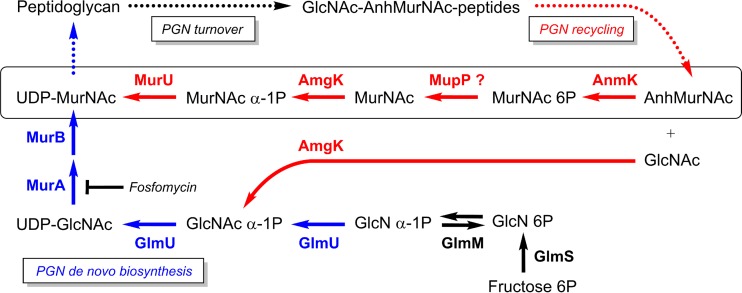FIG 1 .
Simplified scheme of the PGN de novo biosynthesis, turnover, and recycling metabolic pathways of P. putida. The main PGN turnover products GlcNAc-anhMurNAc-peptides (also called anhydro-muropeptides) are formed by periplasmic autolytic enzymes and are reutilized in the process of PGN recycling, which is in red. The transport of anhydro-muropeptides by the permease AmpG and their processing within the cytoplasm, yielding anhMurNAc, GlcNAc, and peptides by the N-acetylglucosaminidase NagZ, the anhMurNAc-peptide amidase (AmpD), and the l,d-carboxypeptidase LdcA, are conserved within Gram-negative bacteria. Also, the anhMurNAc kinase (AnmK) that phosphorylates anhMurNAc, yielding MurNAc 6P, is conserved. However, in P. putida, MurNAc 6P is then recycled, specifically involving an alternative, anabolic recycling route (22), converting MurNAc 6P to UDP-MurNAc. One step of this pathway, the dephosphorylation of MurNAc 6P by a still unknown MurNAc 6P phosphatase that we named MupP, has remained unknown so far. Its product, however, MurNAc, is known to be phosphorylated by the anomeric MurNAc and GlcNAc kinase AmgK, yielding MurNAc α-1P and finally the MurU enzyme that catalyzes the uridylation of MurNAc α-1P to UDP-MurNAc. Thus, the anabolic recycling route provides a shortcut that bypasses the de novo PGN biosynthesis pathway, which is in blue. This recycling pathway, including the enzymes MupP, AmgK, and MurU, leads to increased intrinsic resistance to the antibiotic fosfomycin.

